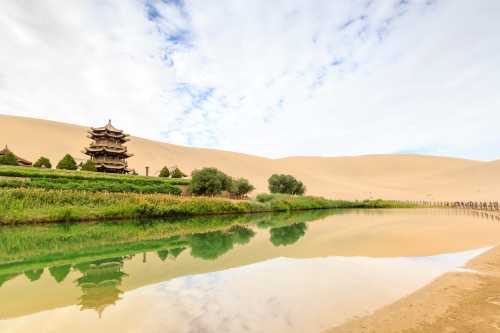Popular Trip Moments
Dunhuang: A Symphony of Millennial Buddha's Light and Desert Oasis | Life advice: You must visit Dunhuang from April to June, because… | Boyfriend's Northwest Travel Guide: 6 Days and 5 Nights | Mogao Caves & Yulin Caves: A Mind-Blowing Experience | Dunhuang Almond Blossoms in Full Bloom | A Five-Day, Four-Night Trip to Northwest China: A Travel Guide (Seriously, Plan Ahead or Go Crazy) | 6 Days and 5 Nights: Qinghai-Gansu Grand Ring Road Fantasy Tour | Don’t you want to come and experience the wonders of nature up close? | Desert trip, you deserve it | Northwest Eight Days and Seven Nights: A No-Detour Itinerary | Is April the best time to visit Dunhuang? | Northwest Grand Circuit Travel Optimization Plan (Peak Season: June-September) | There is more than just desert in Dunhuang. Please save this guide to Dunhuang. | I'm back from Northwest China! Here's my advice... | May Day Reverse Tour | The most comprehensive guide to Dunhuang for 6 days from Xi'an | How to Plan Your First Trip to Northwest China? | Jiuquan Tianjiao Express Hotel is really good! | The hotel's details are very touching. | Here are 3 and 4 reverse travel guides, quickly save them | Crescent Lake: A Pearl in the Desert That Never Dries Up | Sand and water coexist, a wonder in the frontier - Fun tour of Mingsha Mountain | Friends who plan to travel to the northwest in April should not leave so soon | Crescent Moon Lake, Mingsha Mountain, Dunhuang, Gansu | The Great Northwest has a lot of stamina. 8 days and 7 nights of super travel guide | Exploring the Natural Wonders of Gansu and Qinghai, China | 12 Hours at Baisha Lake: From Starlit Plains to Sun-kissed Mountains | Finally, someone has clearly illustrated the Northwest Grand Loop attractions map. | Travel guide to Mogao Grottoes, a famous attraction in Dunhuang City, Gansu Province, China, suitable for checking in and taking photos📸 | My friends all thought I was abroad, but the truth is... | Seven Days in Qinghai and Gansu: Listening to the Heartbeat of the Plateau
Popular Travel Types
Recommended Attractions at Popular Destinations
Bangkok attraction near me | Manila attraction near me | Tokyo attraction near me | Taipei attraction near me | Hong Kong attraction near me | Seoul attraction near me | Kuala Lumpur attraction near me | Los Angeles attraction near me | Shanghai attraction near me | New York attraction near me | Shenzhen attraction near me | Osaka attraction near me | Singapore attraction near me | London attraction near me | Guangzhou attraction near me | San Francisco attraction near me | Beijing attraction near me | Macau attraction near me | Bali attraction near me | Jakarta attraction near me | Paris attraction near me | Ho Chi Minh City attraction near me | Istanbul attraction near me | Phuket attraction near me | Chicago attraction near me | Seattle attraction near me | Toronto attraction near me | Orlando attraction near me | Cebu attraction near me | Chiang Mai attraction near me
Popular Restaurants in Dunhuang
范记靖远羊羔肉 | 夏家合汁(天润花园小区店) | Yangjiazhuangtuyaoguomukaoquanyang | 壹阁胡羊焖饼 | 思露杏皮茶 | 臻品香胡羊焖饼(私房菜) | 泡儿油糕(敦煌商业步行街店) | QI XING LOU GUO MU KAO QUAN YANG | 敦贤居农家乐 | 国辉·羊羔肉·胡羊焖饼(市场巷店) | 妙街胡羊烧烤羊排 | 成都饭馆(月牙泉店) | ZHOUJI MENBINGZI | 敦煌富丽华国际大酒店·中餐厅 | Liuhongxing·xingpishuidian (yueyaquanxiaozhen) | 艾斯汀美食 | 佳韵川菜(月牙泉景区停车场店) | 敦味印象 | Yanglaowuyangroufen Soup | 敦煌山庄咖啡厅 | 清真·敦来顺·手抓羊肉 | 有家驴肉黄面(敦煌店) | 敦煌1900咖啡 | 299 Motorcycle pub | 老字号江海早餐店 | 斑驳民谣故事(万盛公馆店) | Jiafuyuan chuanwangfu | 沙洲胡杨焖饼 | 摘星阁 | 敦煌市老叶家牛羊肉粉汤店
Popular Ranked Lists
Top 10 Local Restaurants in Casablanca | Top 3 Best Things to Do in Jiangmen | Top 3 Best Things to Do in Jiamusi | Top 4 Best Things to Do in Golmud | Top 3 Best Things to Do in Yanji | Top 10 Local Restaurants in Copenhagen | Popular Best Things to Do in Xinxiang | Popular Luxury Hotels in Kieni East | Popular Luxury Hotels in Mirbat | Top 18 Local Restaurants in Seattle | Popular Luxury Hotels in Koyaki | Top 19 Local Restaurants in Kashgar | Popular Best Things to Do in Sheyang | Top 4 Best Things to Do in Daxin | Top 5 Best Things to Do in Gannan | Top 7 Best Things to Do in Yulin | Popular Luxury Hotels Near Lazaro Cardenas Municipality | Top 10 Luxury Hotels in Red Sea Governorate | Top 8 Luxury Hotels in Hurghada | Top 3 Luxury Hotels in Dhaka | Popular Best Things to Do in Zhijiang | Top 10 Local Restaurants in Dublin | Top 17 Local Restaurants in Washington D.C. | Popular Luxury Hotels Near Century City | Popular Luxury Hotels in Dhofar | Top 7 Luxury Hotels in Galle | Top 15 Local Restaurants in Narita | Top 15 Local Restaurants in Detroit | Popular Luxury Hotels Near Recreio dos Bandeirantes | Top 20 Local Restaurants in Nanchang
Payment Methods
Our Partners
Copyright © 2025 Trip.com Travel Singapore Pte. Ltd. All rights reserved
Site Operator: Trip.com Travel Singapore Pte. Ltd.
Site Operator: Trip.com Travel Singapore Pte. Ltd.
















